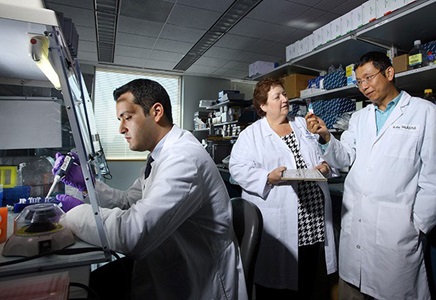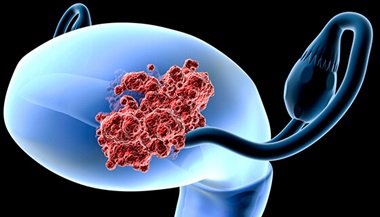Vaginal Cancer
What You Need to Know
- Vaginal cancer is very rare. In the U.S., close to 3,000 women are diagnosed with vaginal cancer each year.
- There is no screening test for vaginal cancer.
- The HPV vaccine can prevent the strains of HPV responsible for most cervical, vaginal and vulvar cancers.
- Risk factors that may increase a woman’s chances of developing vaginal cancer include age, prior diagnosis of HPV and exposure to diethylstilbestrol as a fetus.
- When found early, treatment for vaginal cancer is typically very successful.
What is the vagina?
The vagina is the passageway through which fluid passes out of the body during menstrual periods. It is also called the birth canal. The vagina connects the cervix (the opening of the womb, or uterus) and the vulva (the external genitalia).
What is vaginal cancer?
Cancer of the vagina, a rare kind of cancer in women, is a disease in which malignant (cancer) cells are found in the tissues of the vagina.
There are several types of cancer of the vagina. The two most common are:
-
Squamous cell cancer (squamous carcinoma):
-
Squamous carcinoma is most often found in women older than 60 and accounts for about 70 percent of all vaginal cancers.
-
-
Adenocarcinoma:
-
Adenocarcinoma is more often found in women older than 50 and accounts for about 15 percent of all vaginal cancers.
-
A rare form of cancer called clear-cell adenocarcinoma results from the use of the drug diethylstilbestrol (DES) given to pregnant women between 1940 and 1971 to keep them from miscarrying. It occurs most often in the daughters of the women who took DES.
-
Other Types of Vaginal Cancer
Other, less common types of cancer that can be found in the vagina include:
-
Malignant melanoma
-
Leiomyosarcoma
-
Rhabdomyosarcoma
-
Cancers that begin in other organs, such as the cervix and rectum, and spread to the vagina
Vaginal Cancer Prevention
The HPV vaccine can prevent the strains of HPV responsible for most cervical, vaginal and vulvar cancers.
HPV vaccines can only be used to prevent certain types of HPV. They cannot be used to treat an existing HPV infection. To be most effective, one of the vaccines should be given before a person becomes sexually active.
Vaginal Cancer Causes/Risk Factors
The following factors may increase a woman’s risk of developing vaginal cancer:
-
Age: Almost half of cases are in women 70 or older.
-
Exposure to diethylstilbestrol (DES) as a fetus (mother took DES during pregnancy)
-
History of cervical cancer
-
History of cervical precancerous conditions
-
HPV infection
-
HIV infection
-
Vaginal adenosis
-
Vaginal irritation
-
Smoking
Vaginal Cancer Symptoms
The following are the most common symptoms of vaginal cancer. However, each individual may experience symptoms differently. Symptoms may include:
-
Bleeding or discharge not related to menstrual periods
-
Difficult or painful urination
-
Pain during intercourse
-
Pain in the pelvic area
-
Constipation
-
A mass that can be felt
Even if a woman has had a hysterectomy, she still has a chance of developing vaginal cancer. The symptoms of vaginal cancer may resemble other conditions or medical problems. Always consult a doctor for diagnosis.
Vaginal Cancer Diagnosis
There are several tests used to diagnose vaginal cancer, including:
-
Pelvic examination of the vagina, and other organs in the pelvis: This is done to check for tumors, lumps or masses.
-
Colposcopy: This procedure uses an instrument, called a colposcope, with magnifying lenses to examine the cervix and vagina for abnormalities. If abnormal tissue is found, a biopsy is usually performed; this is called a colposcopic biopsy.
-
Pap test (also called Pap smear): This test involves the microscopic exam of cells collected from the cervix, used to detect changes that may be cancer or may lead to cancer, and to show noncancerous conditions, such as infection or inflammation.
-
Computed tomography scan (CT or CAT scan): This diagnostic imaging procedure uses a combination of X-rays and computer technology to produce horizontal, or axial, images (often called slices) of the body. A CT scan shows detailed images of the body, including the bones, muscles, fat and organs. CT scans are more detailed than general X-rays.
-
Magnetic resonance imaging (MRI): This diagnostic procedure uses a combination of large magnets, radiofrequencies and a computer to produce detailed images of organs and structures within the body.
-
Positron emission tomography (PET) scan: Radioactive-tagged glucose (sugar) is injected into the bloodstream. Tissues that use the glucose more than most normal tissues, such as tumors, can be detected by a scanning machine. PET scans can be used to find small tumors or to check if treatment for a known tumor is working.
-
Biopsy: This procedure removes tissue samples from the vagina for examination under a microscope to determine if cancer or other abnormal cells are present. The diagnosis of cancer is confirmed only by a biopsy.
It is very important that your particular findings be put into context by an expert. Gynecologic oncologists are subspecialists with advanced training in the diagnosis, treatment and surveillance of female cancers, including vaginal cancer.
Treatment for Vaginal Cancer
Specific treatment for vaginal cancer will be determined by your doctor based on:
-
Your overall health and medical history
-
Extent of the disease
-
Your tolerance for specific medications, procedures or therapies
-
Expectations for the course of the disease
Generally, there are three kinds of treatment available for patients with cancerous or precancerous conditions of the vagina:
-
Surgery:
-
Laser surgery to remove the cancer, including LEEP (loop electroexcision procedure)
-
Local excision to remove the cancer
-
Vaginectomy to remove all or part of the vagina
-
Total hysterectomy
-
-
Radiation therapy: the use of X-rays, gamma rays and charged particles to fight cancer
-
Chemotherapy (topical): the use of anticancer drugs to treat cancerous cells
Genetic Testing Aids Early Detection

Johns Hopkins researchers are developing new detection methods for gynecologic cancers. Learn more and discover how genetic testing for these cancers is saving lives.
Obesity and Cancer Risk

Did you know that up to one-third of cancer deaths in women are attributed to excess body weight? Director of Gynecologic Oncology Amanda Fader and oncology dietitian Mary-Eve Brown discuss the correlation between the two. Learn what you can do to reduce your risk.






